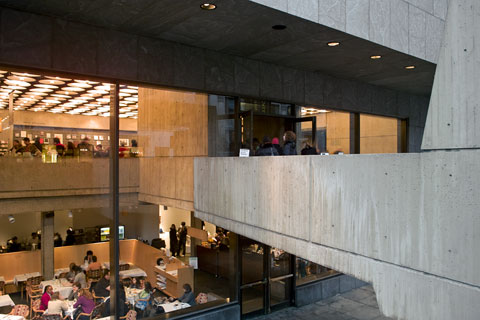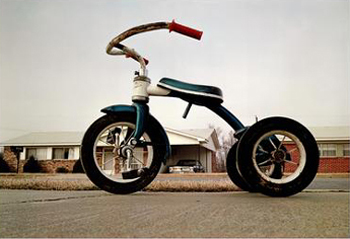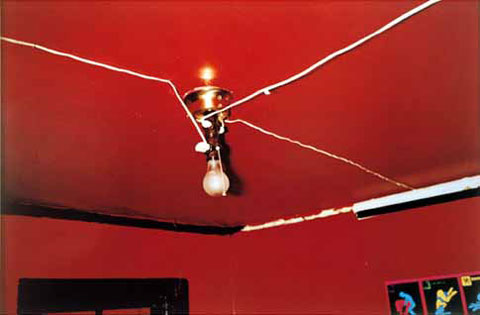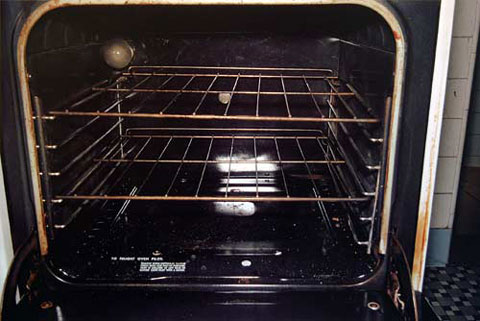New York/Eggleston/The Whitney

The Whitney Museum (digital) © Brian Rose
Neither the Guggenheim nor the Whitney allow photography in their galleries, which makes it difficult for me to review shows in the way I would like to. I've said it before, and will repeat--this does not help the museums or the artists being exhibited. It stifles free speech and hinders the discussion on blogs like this one. I do not buy the usual excuse about protecting copyright. All the images in the Eggleston exhibition, for instance, are readily available in book form, and snapshots taken in a gallery context in no way harm the rights held by the artist.
So, it is with some reluctance that I write about the Whitney William Eggleston show, ironically called Democratic Camera.
•••

Photo by William Eggleston
I've been meaning to write about the Eggleston show for a while now--I've actually been to it twice--once with my son to also take in the Calder circus and early wire figures, and a second time for a more considered look. Before addressing the exhibit specifically, I'd like to talk about how I first became familiar with Eggleston back in the '70s when color photography was relatively new territory.
When I began began taking pictures, like most everyone, I worked in black and white. I learned to develop and print before going to art school, which was around 1975, and always had a home darkroom. I was interested in color, had shot some slide film, and had had a few drugstore prints made. But there was little support from my professors for pursuing color in a serious way. Color was still relegated to commercial photography.
I recall the one color class offered at the Maryland Institute (MICA) in Baltimore where I was at school. For a whole semester students seemed to do nothing but test prints and technical exercises. There was little emphasis on making photographs, so I avoided the class. At some point in 1976 or 1977 I came across Eggleston, Meyerowitz, and Shore in a magazine--just a handful of images--but a light went off in my head, and knew instantly that I would quit black and white photography and pursue color.

Photo by William Eggleston
In 1977 I went off to Cooper Union in New York where Joel Meyerowitz was teaching, and came into contact with other photographers who were shooting color. Although I did not see Eggleston's famous show at the Modern, curated by John Szarkowski, I did get a copy of Eggleston's Guide, which was based on the MoMA exhibition. Those photographs occupy the central galleries of the current Whitney Museum exhibition.
The Guide photos were imprinted in my brain--the vernacular subject matter, the ascerbic color, the utterly unsentimental tossed off quality of the pictures--what I perceived as Eggleston's almost disdainfully insouciant manner. It sat well with this 23 year old photographer.

Photo by William Eggleston
Although I was aware of the themes and places in Eggleston's photographs, I was initially drawn to their formal qualities--how they encompassed the street photography styles of Winogrand and Friedlander--but with the added element of color seemed to rely less on the serendipitous collisions of things within the frame--and allowed for a "blander" less actively composed frame, that dared the viewer to question why? Why point the camera at this building, this street, this oven, this hound dog slurping from a puddle, this flash blinded red room, this monumental tricycle?
More to come...

Photo by William Eggleston
I've been meaning to write about the Eggleston show for a while now--I've actually been to it twice--once with my son to also take in the Calder circus and early wire figures, and a second time for a more considered look. Before addressing the exhibit specifically, I'd like to talk about how I first became familiar with Eggleston back in the '70s when color photography was relatively new territory.
When I began began taking pictures, like most everyone, I worked in black and white. I learned to develop and print before going to art school, which was around 1975, and always had a home darkroom. I was interested in color, had shot some slide film, and had had a few drugstore prints made. But there was little support from my professors for pursuing color in a serious way. Color was still relegated to commercial photography.
I recall the one color class offered at the Maryland Institute (MICA) in Baltimore where I was at school. For a whole semester students seemed to do nothing but test prints and technical exercises. There was little emphasis on making photographs, so I avoided the class. At some point in 1976 or 1977 I came across Eggleston, Meyerowitz, and Shore in a magazine--just a handful of images--but a light went off in my head, and knew instantly that I would quit black and white photography and pursue color.

Photo by William Eggleston
In 1977 I went off to Cooper Union in New York where Joel Meyerowitz was teaching, and came into contact with other photographers who were shooting color. Although I did not see Eggleston's famous show at the Modern, curated by John Szarkowski, I did get a copy of Eggleston's Guide, which was based on the MoMA exhibition. Those photographs occupy the central galleries of the current Whitney Museum exhibition.
The Guide photos were imprinted in my brain--the vernacular subject matter, the ascerbic color, the utterly unsentimental tossed off quality of the pictures--what I perceived as Eggleston's almost disdainfully insouciant manner. It sat well with this 23 year old photographer.

Photo by William Eggleston
Although I was aware of the themes and places in Eggleston's photographs, I was initially drawn to their formal qualities--how they encompassed the street photography styles of Winogrand and Friedlander--but with the added element of color seemed to rely less on the serendipitous collisions of things within the frame--and allowed for a "blander" less actively composed frame, that dared the viewer to question why? Why point the camera at this building, this street, this oven, this hound dog slurping from a puddle, this flash blinded red room, this monumental tricycle?
More to come...

0 Comments:
Post a Comment
Links to this post:
Create a Link
<< Home